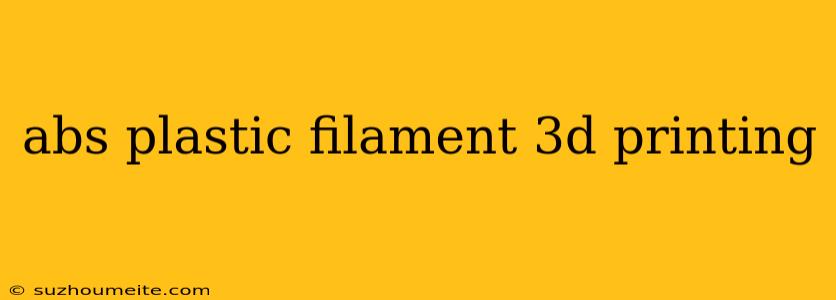ABS Plastic Filament for 3D Printing
ABS (Acrylonitrile Butadiene Styrene) is a popular thermoplastic polymer commonly used in 3D printing. Its versatility, strength, and affordability make it a great choice for a wide range of projects.
What is ABS Filament?
ABS filament is a thermoplastic material that is extruded through a 3D printer's hot end, layer by layer, to create three-dimensional objects. It is known for its toughness, durability, and resistance to chemicals and impacts.
Advantages of ABS Filament:
- High Strength and Durability: ABS is a robust material with excellent mechanical properties, making it suitable for printing objects that need to withstand stress and wear.
- Chemical Resistance: ABS is resistant to a variety of chemicals, making it suitable for printing objects that will be exposed to harsh environments.
- Impact Resistance: ABS is a strong material that can withstand impacts without breaking, making it suitable for printing objects that will be used in high-impact situations.
- Affordable: ABS is one of the most affordable 3D printing filaments available, making it accessible to both beginners and experienced users.
- Widely Available: ABS filament is readily available in a variety of colors and finishes, making it easy to find the right material for your project.
Disadvantages of ABS Filament:
- High Printing Temperatures: ABS requires higher temperatures than some other filaments, which can lead to warping and curling if not properly managed.
- Strong Odor: ABS can emit a strong odor during printing, which may be unpleasant for some users.
- Brittle at Low Temperatures: ABS becomes brittle at lower temperatures, making it less suitable for outdoor applications.
Applications of ABS Filament:
ABS is a versatile material with a wide range of applications, including:
- Prototyping: ABS is an excellent material for prototyping due to its durability and ease of printing.
- Functional Parts: ABS can be used to create functional parts for a variety of applications, such as gears, housings, and enclosures.
- Toys and Games: ABS is a great material for printing toys and games due to its durability and impact resistance.
- Consumer Products: ABS is used in a variety of consumer products, such as kitchenware, tools, and electronics.
Printing with ABS Filament:
To achieve successful prints with ABS, it's essential to:
- Use a Heated Bed: ABS needs a heated bed to prevent warping and curling during printing.
- Adjust Printing Temperature: The optimal printing temperature for ABS is typically between 220°C and 250°C, but this can vary depending on the specific filament and printer.
- Use an Enclosure: An enclosure can help to minimize warping and improve the print quality by providing a controlled environment.
- Post-Processing: ABS can be post-processed to improve its strength, durability, and appearance. This includes smoothing, sanding, painting, and adding finishing touches.
Conclusion:
ABS filament remains a popular choice for 3D printing due to its combination of strength, durability, affordability, and availability. Its versatility makes it suitable for a wide range of applications, from prototyping and functional parts to toys and consumer products. Understanding the characteristics and requirements of ABS can help you achieve high-quality prints and unlock its full potential for your projects.
